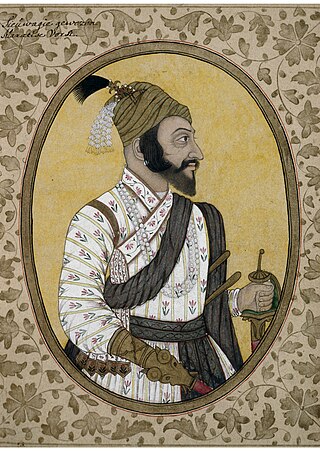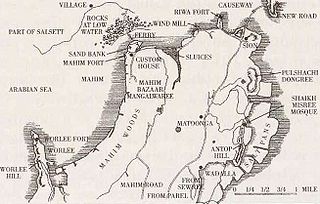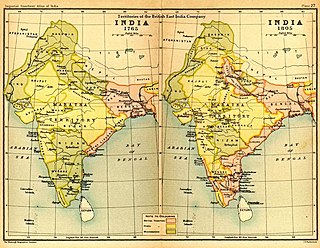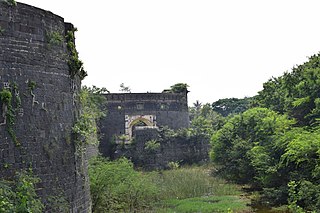
Shivaji I, also referred to as Chhatrapati Shivaji Maharaj, was an Indian ruler and a member of the Bhonsle Maratha clan. Shivaji carved out his own independent kingdom from the declining Adilshahi sultanate of Bijapur which formed the genesis of the Maratha Empire. In 1674, he was formally crowned the Chhatrapati of his realm at Raigad Fort.

The Sion Hillock Fort is a fort in Mumbai (Bombay), India. It was built under the regime of the English East India Company, between 1669 and 1677, atop a conical hillock when Gerard Aungier was the Governor of Bombay. It was notified in 1925 as a Grade I Heritage structure. When it was built, the fort marked the boundary between British-held Parel island and the Portuguese held Salsette Island that lay to the north across the creek.
The Mazagaon Fort was a British fort in Mazagaon, Bombay, in the Indian state of Maharashtra, built around 1680. The fort was razed by the Muslim Koli general, Yakut Khan in June 1690. The fort was located at the present-day Joseph Baptista Gardens, atop Bhandarwada Hill outside the Dockyard Road railway station.

Pune district is a district in Western Maharashtra with Administrative Headquarter in Pune city. Pune district is the most populous district in the Indian state of Maharashtra. It is one of the most industrialised districts in India.

Bombay Castle is one of the oldest defensive structures built in the city of Mumbai. The current castle is a structure built by the British on the site of the Manor House built by a Portuguese nobleman Garcia de Orta. Orta had leased the island of Bombay from the King of Portugal between 1554 and 1570.
Murud is a town and a municipal council in Raigad district in the Indian state of Maharashtra. Situated at a distance of 150 km (93 mi) from Mumbai, Murud is a tourist destination. The Palace of Nawab is located in Murud. The palace was built in 1885 for administration purposes. The palace is still owned by the descendants of the Nawab and is a private property.

The Maratha Conquests were a series of conquests in the Indian subcontinent which led to the building of the Maratha Empire. These conquests were started by Shivaji in 1659, from the victory at the Battle of Pratapgad against Bijapur. The expansion of the empire was limited and interrupted by the Mughal conquests of south India by Mughal emperor Aurangzeb. Marathas were forced to defend their territories against the overwhelmingly strong Mughal army in the 27 years long Deccan wars. They were able to defend their territories and gain an upper hand over Mughals in the sustained conflict.
Chakan is a census town in India, in Pune district of the Indian state of Maharashtra. While agriculture remains an important factor, the town's industrial development is quickly urbanizing the area. The Independent referred Chakan as India's "Motor City".

Purandar Fort is a mountain fort in Pune district in Western Indian state of Maharashtra, India. The fort stands at 4,472 ft above the sea level in the Western Ghats, 50 km to the southeast of Pune.

Panhala fort, is located in Panhala, 20 kilometres northwest of Kolhapur in Maharashtra, India. It is strategically located looking over a pass in the Sahyadri mountain range which was a major trade route from Bijapur in the interior of Maharashtra to the coastal areas. Due to its strategic location, it was the centre of several skirmishes in the Deccan involving the Marathas, the Mughals and the British East India Company, the most notable being the Battle of Pavan Khind. Here, the queen regent of Kolhapur, Tarabai Ranisaheb, spent her formative years. Several parts of the fort and the structures within are still intact. It is also called as the 'Fort of Snakes' as it is zigzagged in shape.

Karnala Fort is a hill fort in Raigad district, Maharashtra, India, about 10 km from Panvel city. Currently it is a protected place lying within the Karnala Bird Sanctuary. It was a place of strategic importance since it overlooked the Bor pass, which connected the Konkan coast to the interior of Maharashtra on the main trade route between these areas.

Korlai Fort is a colonial fort in the Raigad district of Maharashtra, India. Formerly a part of the Chaul in Portuguese India, the structure is a specimen of Portuguese colonial architecture. It was built as a companion to the fort at Chaul, at this strategic position the Portuguese could use it to defend their province which stretched from Korlai to the Fort Bassein. Vestiges of the Portuguese occupation are manifested in the distinct dialect of the Korlai villages inhabitants which is a Luso-Indian creole called Korlai Portuguese Creole.

The Ahmednagar Fort is a fort located near to the Bhingar Nala near Ahmednagar in Maharashtra. It was the headquarters of the Ahmednagar Sultanate. In 1803, it was taken by the British during the Second Anglo-Maratha War. It was used as a prison during the British Raj. Currently, the fort is under the administration of the Armoured Corps of the Indian Army.

Vijaydurg, the oldest fort on the Sindhudurg coast, was constructed during the regime of Raja Bhoja II of the Shilahar dynasty and restructured by Chhatrapati Shivaji Maharaj.

Khandesh is a geographic region in Central India, which includes parts of the northwestern portion of Maharashtra as well as Burhanpur District of Madhya Pradesh.

Maharashtra is a state in the western region of India. It is India's second-most populous state and third-largest state by area. The region that comprises the state has a long history dating back to ca. 1300–700 BCE, although the present-day state was not established until 1960 CE.

Janjira State was a princely state in India during the British Raj. Its rulers were a Siddi dynasty of Habesha descent and the state was under the suzerainty of the Bombay Presidency.














